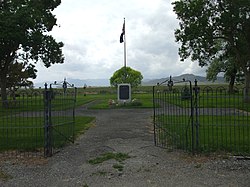Camp Floyd
|
Camp Floyd Site
|
|

Camp Floyd Cemetery in Utah
|
|
| Nearest city | Fairfield, Utah |
|---|---|
| Coordinates | 40°15′26″N 112°6′14″W / 40.25722°N 112.10389°WCoordinates: 40°15′26″N 112°6′14″W / 40.25722°N 112.10389°W |
| Area | 40 acres (16.2 ha) |
| NRHP Reference # | |
|
Stagecoach Inn
|
|

|
|
| Location | 18035 West 1540 North Fairfield, Utah |
| Coordinates | 40°15′41″N 112°5′34″W / 40.26139°N 112.09278°W |
| Area | 1.4 acres (0.6 ha) |
| NRHP Reference # | 71000857 |
| Added to NRHP | May 14, 1971 |
| Added to NRHP | November 11, 1974 |
Camp Floyd was a short-lived U.S. Army post in the Cedar Valley (and now part of Fairfield), Utah, United States. The Stagecoach Inn was a nearby hotel which also served as a stagecoach stop and, during 1860-1861, a Pony Express stop. Both were listed on the National Register of Historic Places in the 1970s, and now are included in a Utah state park known as Camp Floyd / Stagecoach Inn State Park and Museum.
Established in July 1858 by a U.S. Army detachment under the command of Brevet Brig. Gen. Albert Sidney Johnston, Camp Floyd was named for then Secretary of War John B. Floyd. The detachment consisted of more than 3,500 military and civilian employees, including cavalry, artillery, infantry and support units. This unit, the largest single troop concentration then in the United States, was sent by President James Buchanan to stop a perceived Mormon rebellion, which came to be known as the Utah War.
From Fort Leavenworth, Kansas, the army marched to Fort Bridger, Wyoming where it spent the winter of 1857. Troops arrived in Salt Lake City, Utah in June 1858. Soon after their arrival, troops settled in the Cedar Valley area and eventually Fairfield, where 400 buildings were constructed by November 1858. A series of photographs of Camp Floyd, taken by Samuel C. Mills in January 1859, show the post as a cluster of adobe buildings including barracks, officers quarters, warehouses and other sundry structures. Enough civilians soon followed to increase the town size to 7000, almost half that of Salt Lake City. The rebellion never took place, leaving the army with routine garrison duty that included protecting the stagecoach and Pony Express routes, preventing Indian marauding, and mapping and surveying responsibilities.
...
Wikipedia


